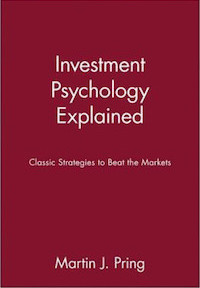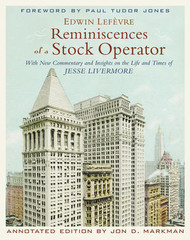Table of Contents
Bob Farrell's 10 Rules
Introduction
Bob Farrell is a Wall Street veteran who draws on some 50 years of experience in crafting his investing rules. After finishing a masters program at Columbia Business School, he launched his career as a technical analyst with Merrill Lynch in 1957. Even though Mr. Farrell studied fundamental analysis under Gramm and Dodd, he turned to technical analysis after realizing there was more to stock prices than balance sheets and income statements. He became a pioneer in sentiment studies and market psychology. His 10 rules on investing stem from personal decades of experience with dull markets, bull markets, bear markets, crashes, and bubbles. In short, Bob Farrell has seen it all and lived to tell about it.
10 Rules
1. Markets tend to return to the mean over time.
Translation: Trends that get overextended in one direction or another return to their long-term average. Even during a strong uptrend or strong downtrend, prices often move back (revert) to a long-term moving average. The chart below shows the S&P 500 over a 15-year period with a 52-week exponential moving average. The blue arrows show several reversions back to this moving average in both uptrends and downtrends. The indicator window shows the Percent Price Oscillator (1,52,1) reverting back to the zero line.
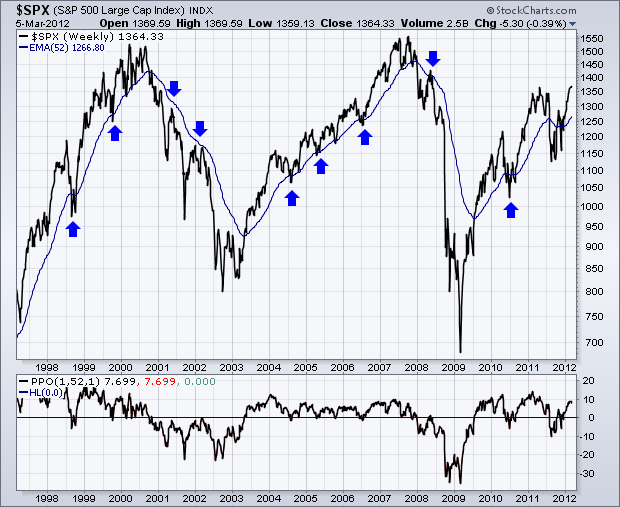
2. Excesses in one direction will lead to an opposite excess in the other direction.
Translation: Markets that overshoot on the upside will also overshoot on the downside, kind of like a pendulum. The further it swings to one side, the further it rebounds to the other side. The chart below shows the Nasdaq bubble in 1999 and the Percent Price Oscillator (52,1,1) moving above 40%. This means the Nasdaq was over 40% above its 52-week moving average and way overextended. This excess gave way to a similar excess when the Nasdaq plunged in 2000-2001 and the Percent Price Oscillator moved below -40%.
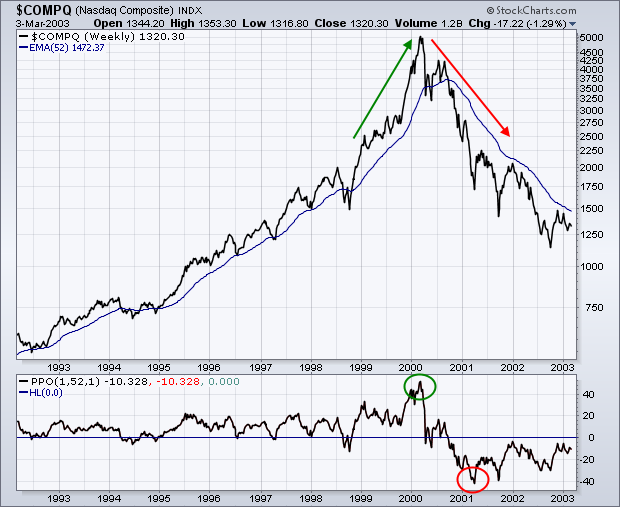
3. There are no new eras – excesses are never permanent.
Translation: There will be a hot group of stocks every few years, but speculation fads do not last forever. In fact, over the last 100 years, we have seen speculative bubbles involving various stock groups. Autos, radio, and electricity powered the roaring 20s. The nifty-fifty powered the bull market in the early 70s. Biotechs bubble up every 10 years or so and there was the dot-com bubble in the late 90s. “This time it is different” is perhaps the most dangerous phrase in investing. As Jesse Livermore puts it:
A lesson I learned early is that there is nothing new in Wall Street. There can't be because speculation is as old as the hills. Whatever happens in the stock market today has happened before and will happen again.
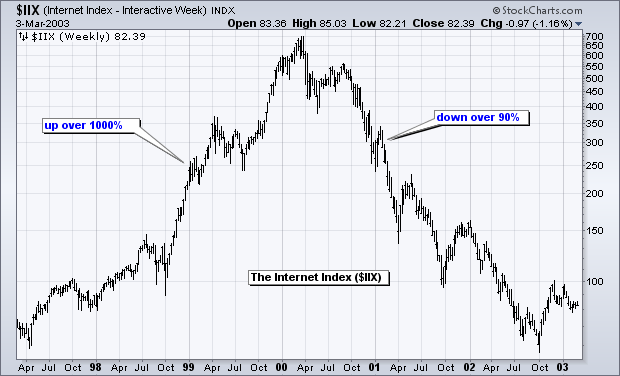
4. Exponential rapidly rising or falling markets usually go further than you think, but they do not correct by going sideways.
Translation: Even though a hot group will ultimately revert back to the mean, a strong trend can extend for a long time. Once this trend ends, however, the correction tends to be sharp. The chart below shows the Shanghai Composite ($SSEC) advancing from July 2005 until October 2007. This index was overbought in July 2006, early 2007 and mid-2007, but these levels did not mark a top as the trend extended with a parabolic move.
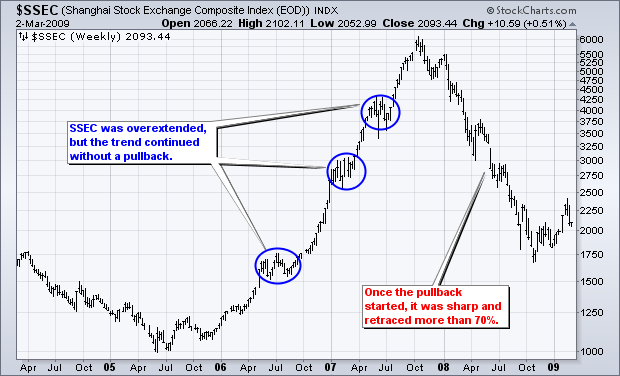
5. The public buys the most at the top and the least at the bottom.
Translation: The average individual investor is most bullish at market tops and most bearish at market bottoms. The survey from the American Association of Individual Investors is often cited as a barometer for investor sentiment. In theory, excessively bullish sentiment warns of a market top, while excessively bearish sentiment warns of a market bottom.
6. Fear and greed are stronger than long-term resolve.
Translation: Don't let emotions cloud your decisions or affect your long-term plan. Plan your trade and trade your plan. Prepare for different scenarios so you will not be taken by surprise with sharp adverse price movement. Sharp declines and losses can increase the fear factor and lead to panic decisions in the heat of battle. Similarly, sharp advances and outsized gains can lead to overconfidence and deviations from the long-term plan. To paraphrase Rudyard Kipling, you will be a much better trader or investor if you can keep your head about you when all about are losing theirs. When the emotions are running high, take a breather, step back and analyze the situation from a greater distance.
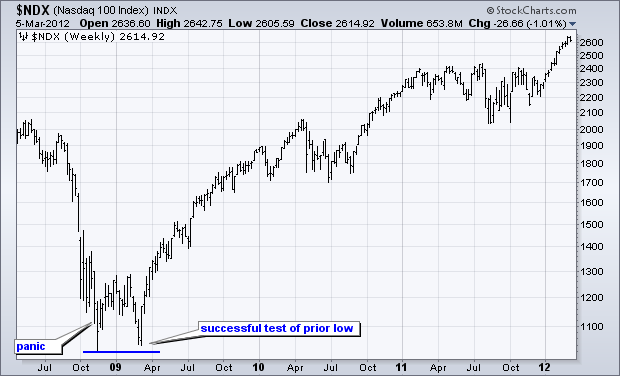
7. Markets are strongest when they are broad and weakest when they narrow to a handful of blue-chip names.
Translation: Breadth is important. A rally on narrow breadth indicates limited participation and the chances of failure are above average. The market cannot continue to rally with just a few large-caps (generals) leading the way. Small- and mid-caps (troops) must also be on board to give the rally credibility. A rally that lifts all boats indicates far-reaching strength and increases the chances of further gains.
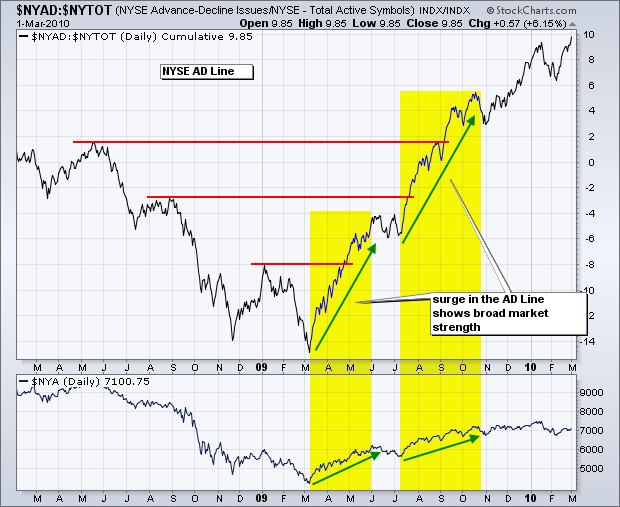
8. Bear markets have three stages – sharp down, reflexive rebound, and a drawn-out fundamental downtrend.
Translation: Bear markets often start with a sharp and swift decline. After this decline, there is an oversold bounce that retraces a portion of that decline. The decline then continues, but at a slower and more grinding pace as the fundamentals deteriorate. Dow Theory suggests that bear markets consist of three down legs with reflexive rebounds in between.
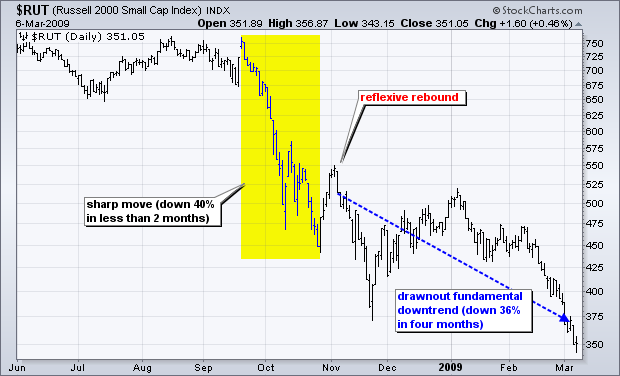
9. When all the experts and forecasts agree – something else is going to happen.
Translation: This rule fits with Farrell's contrarian streak. When all analysts have a buy rating on a stock, there is only one way left to go (downgrade). Excessive bullish sentiment from newsletter writers and analysts should be viewed as a warning sign. Investors should consider buying when stocks are unloved and the news is all bad. Conversely, investors should consider selling when stocks are the talk of the town and the news is all good. Such a contrarian investment strategy usually rewards patient investors.
10. Bull markets are more fun than bear markets.
Translation: Wall Street and Main Street are much more in tune with bull markets than bear markets.
Conclusion
Like all rules on Wall Street, Bob Farrell's 10 rules are not intended to be considered hard and fast or set in stone. There are exceptions to every rule. Nevertheless, these rules will benefit you as a trader or as an investor by helping you to look beyond the latest news headlines or your gut emotions. Being aware of sentiment can prevent traders from selling near the bottom and buying near the top, which often goes against our natural instincts. Human nature causes individual investors and traders to often feel most confident at the top of a market. At the same time, they often feel most pessimistic or cautious at market bottoms. Awareness of these emotions and their potential consequences is the first step towards conquering their adverse effects.
To read our investment psychology article about 11 of the most common cognitive biases affecting investors and traders in financial markets, click here.
